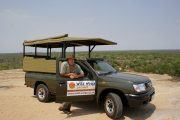



If asked what the best time of the year is to come to the park, I always say it’s the week of the first rain. It has been consistently so over the last few years, and this year it did not disappoint either. It varies from year to year. For the last two years it was somewhere in the beginning of November, but this year it was during the latter part of October. During the last few days we had many lion sightings, cheetahs twice, leopard twice, and black rhino three times. We encountered two separate black rhinos on a morning walk. Fortunately they were at a distance, but we did manage closer views of white rhinos during the walk. While watching three lions sleeping, I noticed a perculiar bird-like sound on the other side of the vehicle and an immediate response from the lions made me look, only to find a cheetah on a termite mound. He was calling for his brother and seemed quite desperate. We followed it for a while as it was searching and chirping. It crossed the road in front of us and suddenly climbed onto a signpost right next to the vehicle. We could hardly have been any closer. Eventually we had to leave him behind in his desperate search. We’ve seen several amazing elephant herds, but one was of particular interest as it contained two albino elephants. One was a calf, but more interestingly, there was also an adult albino female present. Most albino records are of calves, but few occur of adults. The calf was of a different mother though. This was also the time when I saw my fist side-striped jackal for the year. It is the rarer of the two jackal species. Another amazing sighting was of some lions feeding on wildebeest. Initially there were 5 lions but were later joined but 2 others with some aggression as they tried to join in the feast. As the morning continued, hyenas and jackal appeared for their share of the meat. One brave jackal neared very closely to the lions to retrieve a piece of stomach lining. Being successful at it, he thought he could eat it in peace, but did not anticipate the approaching hyena. He was duly chased. Initially he thought he could hold on to the meat but was forced to drop it as the hyena came dangerously close. By this time the vultures have also picked up on the opportunity of a meal and were descending to stay near for when the lions actually left. We observed this spectacle for three hours. All these great sightings were complimented with a civet, genet and honey badger on a night drive. To have such luck in such a short space of time can pretty much only happen during the week of the first rain. Unfortunately, now I have to wait an entire year before it can happen again. However, I’m sure that there will be many amazing trips to fill the gap in between.
Simon Vegter
Wild Wings Safaris
www.wild-wings.co.za




+(Medium)-724786.jpg)
+(Medium)-725415.jpg)
+(Medium)-726383.jpg)
+(Medium)-727211.jpg)


